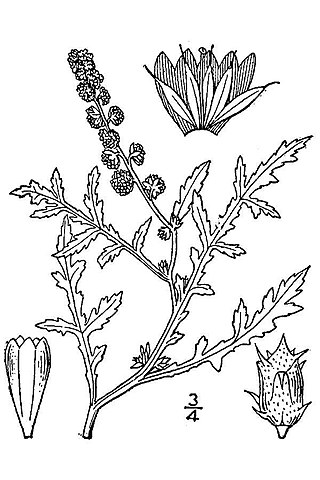
Fouquieria columnaris, the Boojum tree or cirio is a tree in the ocotillo family,(Fouquieriaceae) whose other members include the ocotillos. Some taxonomists place it in the separate genus Idria. It is nearly endemic to the Baja California Peninsula, with only a small population in the Sierra Bacha of Sonora, Mexico. The plant's English name, Boojum, was given by Godfrey Sykes of the Desert Laboratory in Tucson, Arizona and is taken from Lewis Carroll's poem "The Hunting of the Snark".

Fouquieria splendens is a plant indigenous to the Sonoran Desert and Chihuahuan Desert and Colorado Desert in the Southwestern United States, and northern Mexico.

Ragweeds are flowering plants in the genus Ambrosia in the aster family, Asteraceae. They are distributed in the tropical and subtropical regions of the Americas, especially North America, where the origin and center of diversity of the genus are in the southwestern United States and northwestern Mexico. Several species have been introduced to the Old World and some have naturalized and have become invasive species. Ragweed species are expected to continue spreading across Europe in the near future in response to ongoing climate change.

Ambrosia artemisiifolia, with the common names common ragweed, annual ragweed, and low ragweed, is a species of the genus Ambrosia native to regions of the Americas.

Ambrosia dumosa, the burro-weed or white bursage, a North American species of plants in the family Asteraceae. It is a common constituent of the creosote-bush scrub community throughout the Mojave desert of California, Nevada, and Utah and the Sonoran Desert of Arizona and northwestern Mexico.

Stenocereus thurberi, the organ pipe cactus, is a species of cactus native to Mexico and the United States. The species is found in rocky desert. Two subspecies are recognized based on their distribution and height. The Organ Pipe Cactus National Monument is named for the species.

Ambrosia trifida, the giant ragweed, is a species of flowering plant in the family Asteraceae. It is native to North America, where it is widespread in Canada, the United States, and northern Mexico.

Vachellia constricta, also known commonly as the whitethorn acacia, is a shrub native to Mexico and the Southwestern United States, with a disjunct eastern population in Virginia and Maryland.

Trixis californica , the American threefold or American trixis, is a species of flowering plant in the family Asteraceae. It is native to the southwestern United States in California, Arizona, New Mexico, and Texas, and in Mexico in the states of Baja California, Chihuahua, Coahuila, Durango, Nuevo León, Sinaloa, Sonora, Tamaulipas, and Zacatecas.

Ambrosia chamissonis is a species of ragweed known by the common names silver burr ragweed, silver beachweed and (silver) beach bur(r).

Fouquieria is a genus of 11 species of desert plants, the sole genus in the family Fouquieriaceae. The genus includes the ocotillo and the Boojum tree or cirio. They have semisucculent stems with thinner spikes projecting from them, with leaves on the bases spikes. They are unrelated to cacti and do not look much like them; their stems are proportionately thinner than cactus stems and their leaves are larger.

Ambrosia chenopodiifolia is a species of ragweed known by the common names San Diego bursage and San Diego bur ragweed. It is native to the Mexican states of Baja California and Baja California Sur, as well as to Orange and San Diego Counties it int US State of California. It is a member of the coastal sage scrub plant community.

Ambrosia eriocentra is a North American species of ragweed known by the common names woolly bursage and woollyfruit burr ragweed.
Ambrosia ilicifolia is a species of ragweed known by the common names hollyleaf burr ragweed and hollyleaf bursage.

Ambrosia pumila is a rare species of herbaceous perennial plant known by the common names San Diego ragweed and San Diego ambrosia. It is native to far southern California, Baja California, and Baja California Sur. It grows in floodplains and open grasslands in proximity to wetland areas.

Ambrosia tomentosa, the skeletonleaf bur ragweed, silverleaf povertyweed, or skeleton-leaf bursage, is a North American species of perennial plants in the family Asteraceae.
Ambrosia deltoidea is a North American species of flowering plant in the family Asteraceae known by the common names triangle bur ragweed, triangle bursage, and triangleleaf bursage.
Ambrosia linearis is a species of flowering plant in the family Asteraceae known by the common names streaked bur ragweed, Colorado bursage, linear-leaf bursage, and plains ragweed. It is endemic to east-central part of the state of Colorado in the United States, where it occurs in Elbert, Pueblo, El Paso, Cheyenne, Crowley, Kiowa and Lincoln Counties.

Ambrosia salsola, commonly called cheesebush, winged ragweed, burrobush, white burrobrush, and desert pearl, is a species of perennial shrub in the family Asteraceae native to deserts of the southwestern United States and northwestern Mexico.
Ambrosia cordifolia, called the Tucson bur ragweed, is a North American species of plant in the family Asteraceae. It is native to northern Mexico and the State of Arizona in the United States.

















